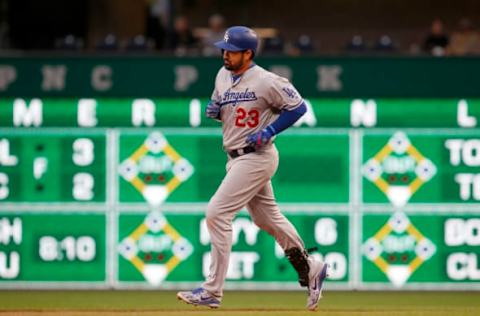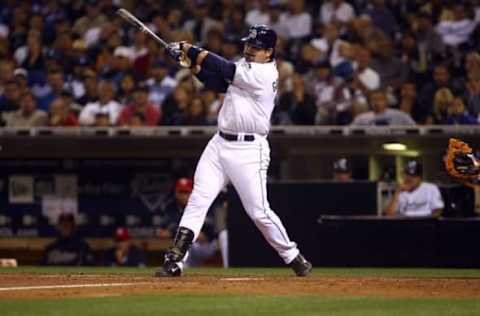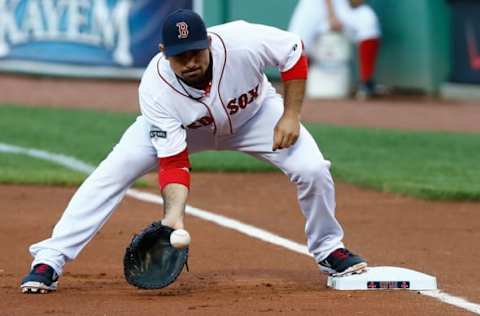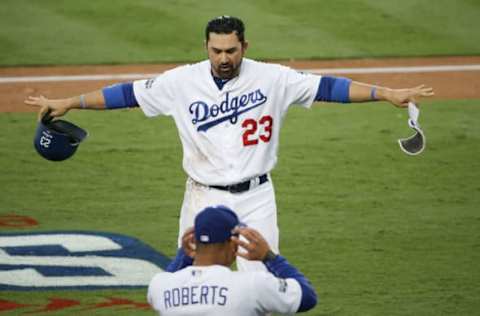Grade the Trade: Adrian Gonzalez trade history retrospective


In the year 2000, the Florida Marlins kicked off a new century of MLB drafts by selecting Adrian Gonzalez first overall. A rather uncanny future lied ahead for the talented first pick.
During his nearly two-decade long professional career, Gonzalez has been involved in four trades. Although this isn’t a record-breaking total, it is unusual for a first-overall pick who panned out to get dealt so often.
Gonzalez has hit over 300 MLB home runs and is the recipient of four Gold Gloves. He’s been an All-Star five times for three different times. His extensive MLB career has taken him to all corners of the country, while representing a total of five different franchises. Not all teams who have traded for Gonzalez actually won the deal as they either gave up too much for his talents or sold him far too low.
Rather than look at any one particular trade, Gonzalez is worthy multiple report cards. The four trades he was involved in helped shape baseball. Many still have an effect on the game today.
Florida Marlins trade Gonzalez to Texas Rangers
Before he even received an inning in the big leagues, the Marlins traded Gonzalez to the Rangers in July 2003. Several others were included in this deal which brought the Marlins relief pitcher Ugueth Urbina.
Urbina was not pitching particular well for the Rangers at the time this trade took place. However, once he arrived in South Florida, his fortunes turned around.
In 38.1 innings for the Marlins, Urbina was 3-0 with a 1.41 ERA. As a mercenary brought in to help the Marlins win, he served his purpose. The Marlins went on to win the 2003 World Series while essentially closing out the New York Yankees’ dynasty in the process.
The cost of acquiring Urbina for a few months was steep. The Marlins dealt a borderline Hall of Famer for one World Series trophy. Considering this is the ultimate goal of all teams, there’s no arguing against it.
Award the Marlins with a passing grade here and the Rangers with a TBD. If you know your Adrian Gonzalez history, though, you’ll already predict it involves some summer school classes.

Rangers trade Gonzalez to the San Diego Padres
The trade that helped put Gonzalez’s name into more households took place in the winter of 2006. The Rangers packaged him together with Termel Sledge and pitcher Chris Young. In exchange, the Padres sent them pitcher Adam Eaton, Akinori Otsuka, and career minor leaguer Billy Killian. It’s clear from the start who won this deal; and it’s not the one in Texas.
Gonzalez saw limited action with the Rangers in 2004 and 2005. He didn’t hit very well thus leading to this questionable trade. In his first year with the Padres, Gonzalez made the Rangers regret their actions. He slashed a robust .304/.362/.500 with 24 home runs. None of the players the Rangers received put up numbers anywhere near what Gonzalez did in San Diego.
Over his five seasons with the Padres, Gonzalez hit 161 home runs while batting .288. He was an All-Star three times and earned MVP consideration in several of those seasons. One year, he even managed to hit 40 home runs at PetCo Park.
The Rangers got very little in this return. Eaton pitched horribly in his one season with them. Otsuka did well, but only stayed in the big leagues for another two seasons. It would appear that the Rangers gave up on Gonzalez prematurely before he was ready to start blasting home runs with regularity.
At the risk of spoiling the other trades involving Gonzalez, this was the most lopsided of all. Since Gonzalez wasted no time in producing, it was impatience which cost the Rangers most in this transaction. Had they kept him for even one more year, they might not be as championship starved as they are more than a decade later.

Padres trade Gonzalez to Boston Red Sox
After the 2010 season, the Padres were ready to give Gonzalez a better shot to compete. Gonzalez packed up his things and joined the Boston Red Sox for what became a very productive season and a half.
Gonzalez led the league with 213 hits in 2011. He did so with 27 home runs and 117 RBI. The move to Fenway Park improved his batting average significantly from an already solid .298 in 2010 to an outstanding .338 in 2011. I’ll get to how it all ended shortly. For now, let’s examine who the Padres got in return.
This trade ended up including four moving from the Padres’ organization to Red Sox. They included Rey Fuentes, Casey Kelly, Eric Patterson, and the only guy who might have saved this trade from becoming lopsided: Anthony Rizzo.
Rizzo would have been an amazing replacement for Gonzalez. The current Chicago Cubs’ first baseman is capable of doing everything A-Gon was in his early career. Unfortunately, the Padres refused to let this happen. They ended up trading him to the Cubs in what was essentially a deal for pitcher Andrew Cashner. Others were involved in the trade, too, but the main purpose was for the Padres to land a young pitcher they liked and for the Cubs to find a first baseman of the future.
If we factor this in, this trade looks even worse for the Padres. They didn’t get anything of great value in return for one of the league’s best first basemen. Without Rizzo putting up incredible numbers in San Diego or turning him into a better or equal piece through another trade, the Padres get a big fat F in this trade’s grade.
The Red Sox, meanwhile, earn themselves a passing grade; though, imagine if they had kept Rizzo and skipped adding Gonzalez. He was essentially a productive regular season player that never had his chance to see Red Sox postseason baseball. In retrospect, the deal was a draw more than anything else.

Red Sox trade Gonzalez to the Los Angeles Dodgers
The final blockbuster deal to include Gonzalez came in August 2012. Before the recent Justin Verlander trade, it’s safe to say it was the biggest deal in August after the non-waiver trade deadline.
More from Call to the Pen
- Philadelphia Phillies, ready for a stretch run, bomb St. Louis Cardinals
- Philadelphia Phillies: The 4 players on the franchise’s Mount Rushmore
- Boston Red Sox fans should be upset over Mookie Betts’ comment
- Analyzing the Boston Red Sox trade for Dave Henderson and Spike Owen
- 2023 MLB postseason likely to have a strange look without Yankees, Red Sox, Cardinals
To dump payroll and change the culture, the Dodgers shipped Gonzalez to the Dodgers. He wasn’t alone either. Josh Beckett, Carl Crawford, and Nick Punto all flew with him to the West Coast. In the opposite direction went a slew of rather insignificant players. The most notable of them was James Loney.
Unlike many trades, the lone purpose of this one for the Red Sox was to save money. The locker room had become toxic. Even though Gonzalez wasn’t one of the major culprits, he held some value to the Dodgers.
Los Angeles wasn’t about to take on three huge contracts without getting some talent along with it. Beckett and Crawford’s underwhelming performance in Boston needed a boost. By including Gonzalez, the Dodgers willingly accepted the payroll burden.
Like an open-ended essay, this is the most difficult trade to grade. The Dodgers landed the best player(s) in this trade. Considering the purpose of this deal, much more must be factored in.
The Red Sox won the World Series the very next year thanks in large part to this trade. It was the definition of a “one-step back, two-steps forward” move. Their openness to trade one of their best offensive weapons ultimately led to them winning their second World Series in less than ten years.
Next: August trade flurry a growing trend?
Meanwhile, the Dodgers landed a really good player who gave them several productive years. Gonzalez’s time as a star is now in the rearview mirror, but in this trade’s case, both teams get passing grades.